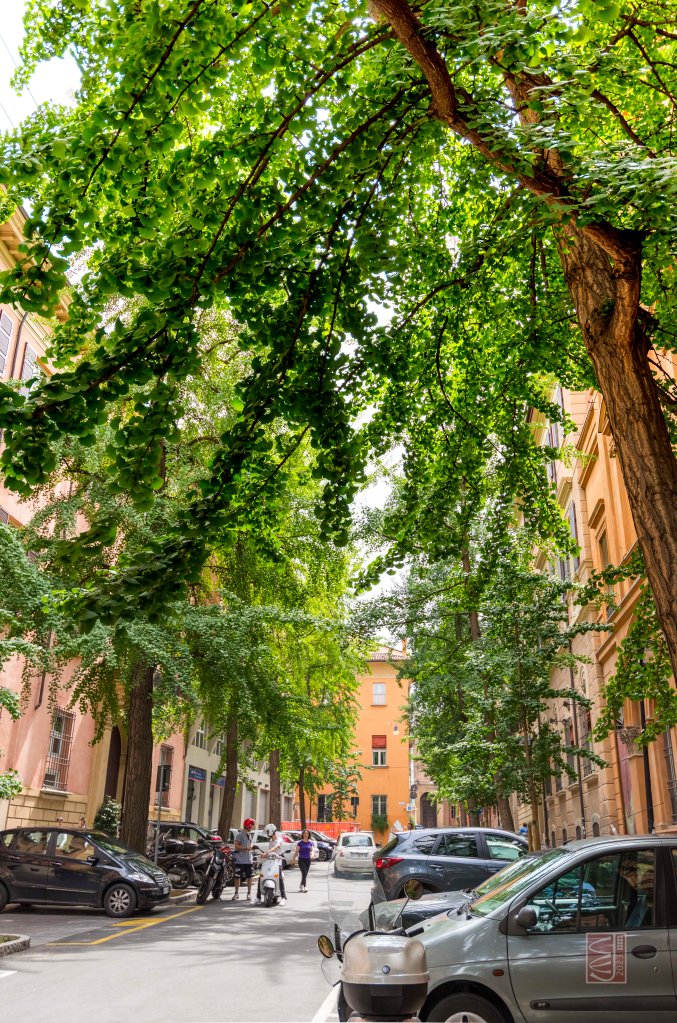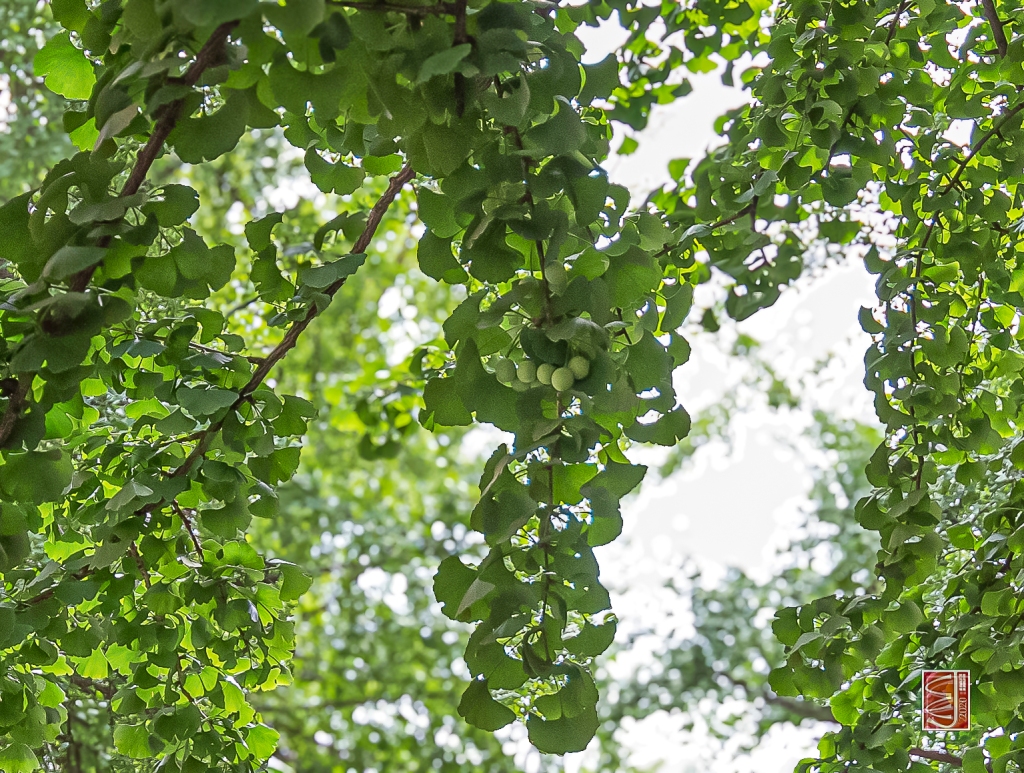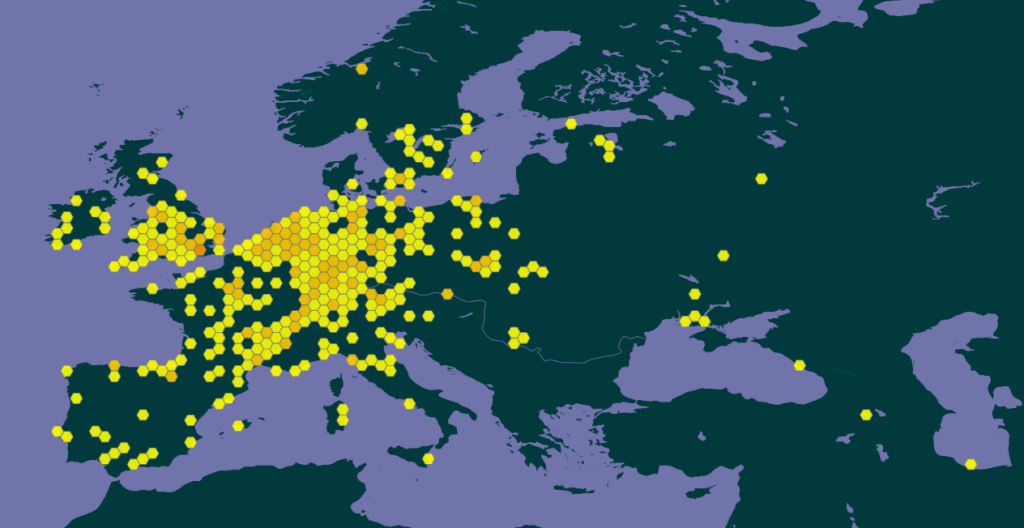Ginkgo biloba is known as a ‘living fossil’. This tree is the sole survivor of a group that emerged nearly 300 million years ago (MYA) and flourished in the Jurassic (200-145 MYA) until a decline in the late Cretaceous (100-66 MYA ). Ginkgo has survived, more-or-less unchanged, for at least 200 million years. Ginkgo biloba retains its ‘primitive’ features: just like cycads, mosses, ferns and algae it has motile sperm cells (in Ginkgo each sperm cell has several thousand flagellae).

Clusters of Ginkgo leaves developed on ‘short-shoots’ along the branch. Image: Richard Milne.
It is an attractive tree, much-planted as a ‘street tree’ in warmer parts of the world. I’ve admired it during my travels to the far east as well as locations in Europe. We’ve got one in our garden, in a pot. It has survived several harsh winters, and now its buds are swelling ready for spring.

Rows of Ginkgo along a street in Bologna, Italy. Imagine how dull this street would be without such trees, and consider too the useful shade and the cooling effect of transpiration. Image: Chris Jeffree.
The leaves of Ginkgo biloba resemble many of the fossil ginkgoales. They are fan shaped and the veins do not form a net as in the ‘modern’ leaves of angiosperms. Instead, they divide several times from the leaf base to the leaf margins, being thicker at the leaf base. The lack of a network of veins might seem inherently inefficient, limiting the tolerance to drought and restricting the transport of compounds to and from the photosynthetic machinery. A detailed analysis of the transport architecture of ginkgo leaves is presented by Carvalho et al (2017). As in all transport systems (rivers, lungs, blood circulation, road systems) the branching structures in trees are expected to follow fairly simple physical principles. These authors found that Ginkgo falls somewhere in between the two classical models of transport: one was first suggested by Leonardi da Vinci (‘pipe model theory’, developed later in Japan) and the other, a more modern one, is rather complex. Neither models fitted the case of Ginkgo. However, the tree can survive drought and famously was one of the few survivors at the site of the atom bomb that devastated Hiroshima (August 1945). One tree was within 2 km of the epicentre.

An old Ginkgo tree in Kunming, China. Image: Richard Milne.
It comes from China but there has been much discussion on whether truly wild populations still exist. Many Chinese authors have pointed to a population of about 200 trees on Mount Tianmu (‘Heavenly Eyes Mountain’) in Eastern China, perhaps the only place where relic populations can be found. However, a recent study identifies relic populations in eastern, southern and south-western China (Lin et al 2022). The tree grows along flood-disturbed stream-sides in warm-temperate deciduous forests. From China it was introduced to other eastern countries from the 6th Century onwards. Later, it came to Europe (Utrecht in 1730, Kew Gardens in 1754) and then to North America (1784).
Recently Chinese scientists have examined the genomes of 545 ginkgo trees from all over the world, to find out more about the role of humans in dispersing the species to other continents (Zhao et al 2019). They found four clades of Ginkgo biloba within China, occupying different regions. However, the trees that came to Europe all seem to be derived from populations in the eastern part of China.
Their paper is long and detailed, and here I will quote just one important conclusion.
“How ginkgo was introduced into various areas across the continents is another longstanding controversy, although it is well acknowledged that ginkgo trees have been increasingly planted across Europe and America since the 18th century. Our analyses based on multiple approaches clearly showed multiple introductions of Chinese ginkgo trees into North America and Europe but refuted the possibility that European ginkgo originated from either Japan or Korea”.

This female tree is carrying the apricot-like reproductive structures (seeds with a soft shell). The seeds produce butyric acid and smell bad, but they are eaten in China. Image: Chris Jeffree.
The reproductive biology of the species is described in the recent review by Lin et al. (2022). The species is dioecious (separate male and female plants). The male ‘blossoms’ are produced early in the year, just before the leaves. They disperse the boat-shaped pollen, some of which becomes captured in the tiny drop of mucilage produced by the female structures, also called ’blossoms’. Once drawn into the ovule the male gametes are released from the pollen in the form of mobile sperm cells (multi-flagellated spermatozoids) and after fertilisation the seeds are shed. The embryos continue their development after this (the seed is dormant for around 4 months). These processes are best communicated via diagrams from the freely-down-loadable book edited by Van Beck (2000), which for copyright reasons I cannot show in this blog.

Female reproductive structures in the spring, generally called ‘blossoms’. The tiny drops of mucilage can be seen, on which the pollen will be captured. Image: unknown author via Wikimedia Commons CC BY-SA 3.0 https://creativecommons.org/licenses/by-sa/3.0,
Some people have speculated that the main agents of seed dispersal for Ginkgo would have been dinosaurs. In Botanic gardens these days it might be squirrels.
The trees may grow to a great age. The oldest (found at temple sites) are said to be 2000 years old and up to 50 metres tall. Mature trees may be multi-stemmed as they develop new stems from below ground (‘basal chichi’) or on the main stem, above the ground (the ’aerial chichi’).
The tree is grown commercially, not for timber but for the medicinal compounds which can be extracted from various parts of the plant. Several chapters in Van Beck’s book describe the chemistry along with details of the extraction process. Extracts can be purchased from health food shops as a dietary supplement and there are many articles on the internet concerning possible health benefits. https://www.webmd.com/vitamins-and-supplements/supplement-guide-ginkgo-biloba.

Leafless branches in early February 2024. Note the development and arrangement of the ‘short-shoots’ that will soon carry rosettes of leaves. Image: John Grace.
You might wonder if you can grow it yourself. Almost certainly you can. It needs good light but it grows well outdoors. I looked up the average climate of its native Mount Tianmu: annual rainfall is 1767 mm, January temperature is -3.2 degrees and July temperature is 20.5 degrees. Here is Scotland we are warmer in winter, colder in summer and generally not quite as wet. But I am keeping my eye on one Ginkgo tree at Castle Kennedy in SW Scotland (where January is 5 degrees, July is about 15 degrees and rainfall is 1027 mm). It is doing well against the castle wall.


Global and European distribution of Ginkgo biloba. Although only a few records are shown for Scotland, I am sure there are many unrecorded locations. Recorders often ignore trees that grow in parks and gardens. Data from GBIF.
The plant was described and named ‘Ginkgo’ by Linnaeus in 1771. Later authors pointed out that, to be faithful to its Chinese and Japanese name, it should have been called ‘Ginkgyo’. It is thought that Linneaus made a simple spelling mistake but the taxonomic rule of precedence meant that a correction was not allowed. The english name ‘Maidenhair tree’ was given because the leaves resemble those of Maidenhair ferns (Adiantum sp.)
References
Carvalho MR et al. (2017) The hydraulic architecture of Ginkgo leaves. American Journal of Botany 104, 1285-98. https://bsapubs.onlinelibrary.wiley.com/doi/full/10.3732/ajb.1700277
del Tredici P (2000) The evolution, ecology, and cultivation of Ginkgo biloba (in the downloadable book edited by TA Van Beck, published by Harwood Academic, called Gingko biloba). https://endchan.org/.media/d3d6dbbf2582ac1b83f01d8b322ed9db-applicationpdf.pdf#page=16
Lehnebach R et al.(2018) The pipe model theory half a century on: a review. Annals of Botany, 121, 773–795. https://doi.org/10.1093/aob/mcx194
Lin H-Y (2022) International Biological Flora: Ginkgo biloba L. Journal of Ecology doi 10.1111/1365-2745.13856.
TA Van Beck, editor (2000) Ginkgo biloba. Harwood Academic. Freely downloadable.
Zhao Y-P (2019) Resequencing 545 ginkgo genomes across the world reveals the evolutionary history of the living fossil. Nature communications 10, 4201. https://doi.org/10.1038/s41467-019-12133-5
©John Grace
Your fossil plant is a true gem among Earth’s treasures.
LikeLike